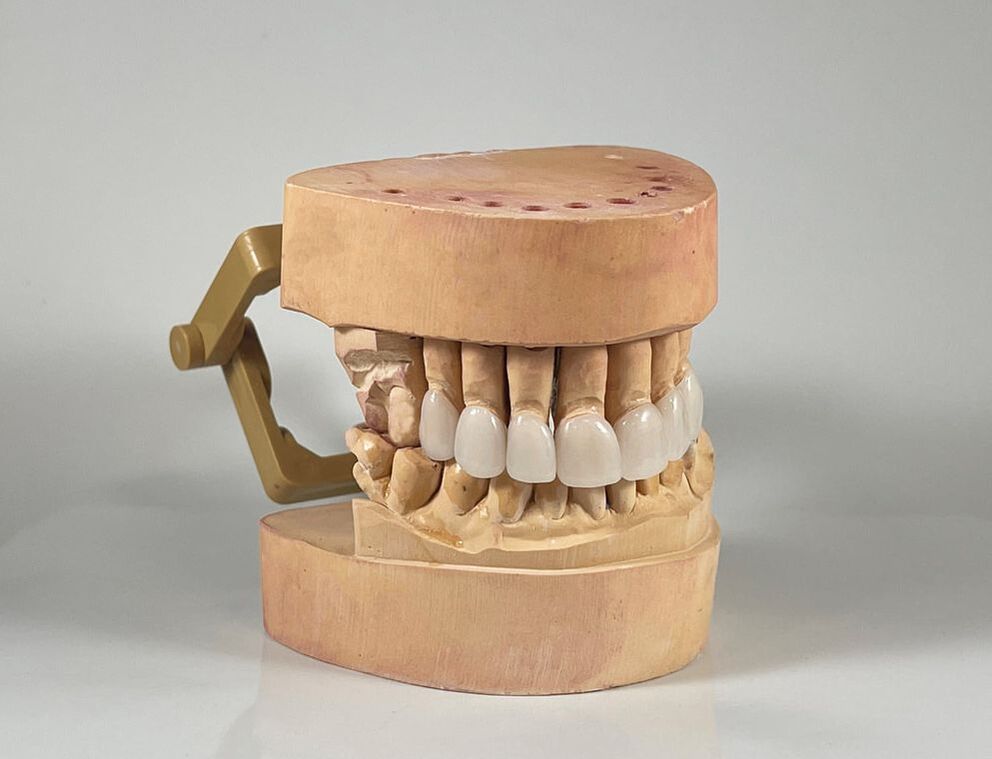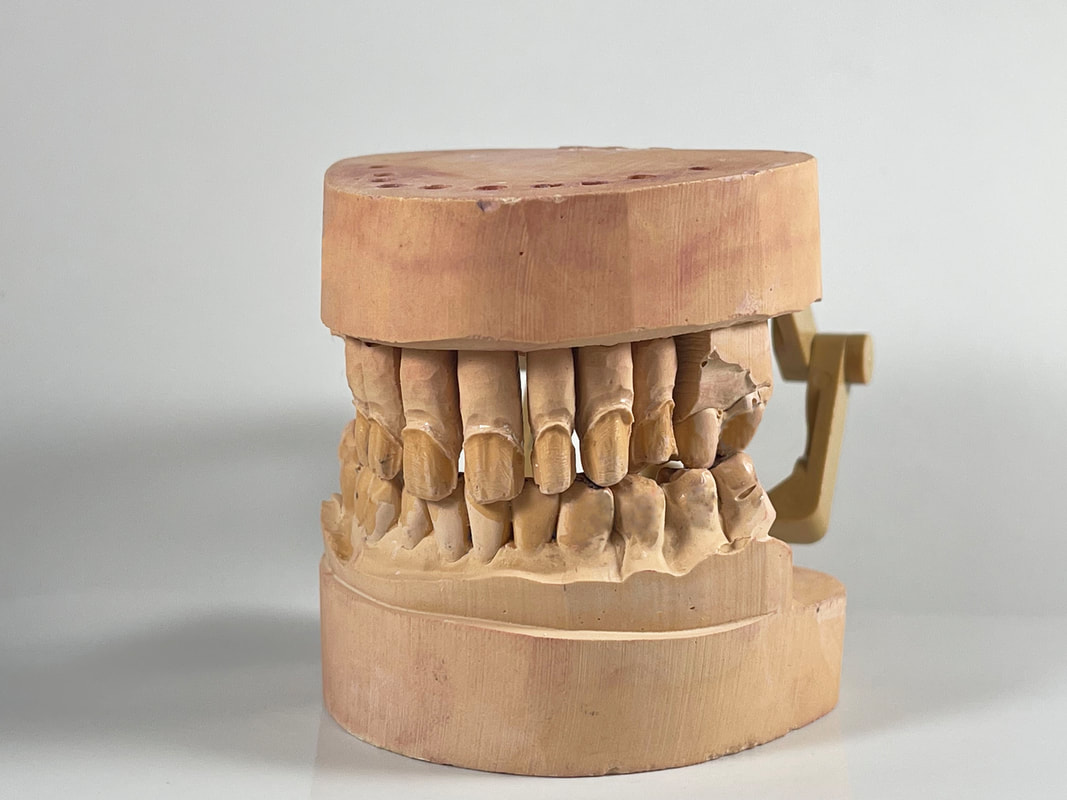What Are Porcelain Veneers?Porcelain is the most common material used for dental veneers and has been used in dentistry since the 1920's. They are wafer-thin, patient-customized shells created by a skilled dental technician. They are fabricated by an expert eye and hand to fit the patient’s dental anatomy and smile. There are versatile ceramic options, including feldspathic porcelain, lithium disilicate, and zirconia. Feldspathic porcelain comes in the form of land-layered powder or liquid. It is known for it high aesthetics. However, it is a fairly fragile material that can easily crack or chip. This combined with the traditional, hand-crafted techniques, is the reason why many dentists are choosing more modern materials and fabrication methods for veneers. Veneers made from Emax lithium disilicate use modern CAD/CAM (compute-aided design and manufacturing) technology and conventional techniques. The technology allows for a completely automated workflow that results in natural-looking restorations. Solid blocks of the ceramic material can be digitally milled for an exact fit. On the other hand, veneers can also be made through heat-pressing techniques with pressable lithium disilicate ingots. CAD/CAM systems can be used chairside and accomplished in one appointment. Lithium disilicate is a glass ceramic material with a 70% concentration of ceramic crystals throughout. The material results in high-performing aesthetics, biocompatibility, and integration. Additionally, the structure helps to obtain great flexural strength--up to three times greater than feldspathic veneers. Overall, the material possesses an average lifespan of 15 to 20 years with proper care. Zirconia is a relatively new material to the veneers market. Zirconia veneers are milled with CAD/CAM processes. Monolithic zirconia is used to make strong veneers that lack the bulky appearance that other materials may cause. It's wear resistance allows veneers to be thin, while withstanding fractures or cracks. Zirconia offers more flexural resistance than other materials, allowing it to combat damage better. It has a long history of addressing parafunctional habits, such as bruxism of teeth clenching. The material is very thin and translucent, allowing the dental technician to layer on different shades to achieve a natural look. It is also highly biocompatible and unlikely to adversely affect the gum tissue. The finished results are extremely durable dental veneers that do not stain, chip, or discolor that easily, often lasting up to 10 to 15 years with proper care. However, longevity can also vary depending on the cementation method and patient behaviors, such as oral hygiene, nail-biting, ice-chewing, etc. Cost of Porcelain VeneersCosts can range from $500-$2,500 per tooth, depending on the material and complexity. Additional services, such as custom staining may also impact the overall cost for both the patient and the dentist. The laboratory charge to the dentist can range from $150 to $400 per veneer. Ceramic-based materials, including lithium disilicate and zirconia are more costly. These veneers range from $900 to $2500. Despite the initial cost, ceramic veneers are often deemed the most cost-effective due to their exceptional lifespan and durability. PORCELAIN VENEER PROCEDUREVeneer preparation is vital for a natural and seamless finished result. Adequate tooth reduction is necessary for prepping teeth for veneers. Each material requires their own specific preparation procedure and minimum uniform thickness of the material itself. Depending on material strength, durability, and patient habits, the overall thickness will vary. Feldspathic porcelain veneers need to be relatively thick to make up for their fragility. This also means the tooth preparation for veneers is rather aggressive. There needs to be a lot of tooth reduction in order to make room for the restorations. Starting with a uniform facial reduction of 1.0 to 1.5 mm, a 0.3 mm chamfer margin is to be created at the interproximal edges. Then, a 0.5 mm subgingival margin should be created before the incisal edge of the tooth is reduced by 1.0 to 2.0 mm. Lithium disilicate veneers require less reduction than feldspathic. Using a medium-grit, rounded-end diamond bur, a uniform facial reduction of 0.8 to 1.0 mm is required. Then, the incisal edge is reduced by 1.0 to 1.5 mm and the chamfer margin is created. Zirconia veneers are also minimally invasive compared to feldspathic. The incisal edge and face of the tooth should be uniformly reduced by 0.7 to 1.25 mm before blending the margins into the interproximal spaces with a 0.3 mm chamfer. However, with zirconia veneers, the axial walls may not have any undercuts. The procedure for porcelain veneers requires minimal preparation, but has a lengthy manufacturing time. Typically, the dentist will prepare by shaving down some of the tooth’s enamel to make room for the veneer. Impressions for the dental lab are taken so that a technician can customize the veneer to the patient’s exact bite. A CAD/CAM workflow can help guarantee smooth preparations with increased accuracy. During the manufacturing period, the patient may receive temporary veneers. At the following appointment, the dentist will place the veneer by cleaning and acid-etching the tooth’s surface before applying an adhesive cement. After hardening the cement with a blue light, the excess is removed so the dentist can properly assess the new bite. Follow-up appointments may be necessary for adjustments.
COMPOSITE VENEERSComposite veneers are the second main type of veneers. Rather than porcelain, they are created from a bonding resin that is a mixture of both organic and inorganic materials. Some of the natural materials include the initiator, the resin, and the coupling agent. The filler makes up the primary inorganic material. The composite resin is the same as what is used for tooth-colored dental fillings. Composite veneers have a shorter lifespan than porcelain veneers. They typically average 4 to 8 years, and replacements are needed more often and sooner than porcelain. There are two methods for performing composite veneers: direct and indirect. Through the direct method, the dentist will sculpt composite directly on the prepared tooth. These can often be placed in one office visit. If made indirectly, a dental laboratory creates the restoration before a dentist bonds it in place. A second appointment may be required to accommodate manufacturing time. Cost of Composite VeneersComposite resin is the least expensive and least invasive veneers option today. They cost around half the price of porcelain veneers: $250-$1,500. The cost depends on the placement method and the complexity of the case. They are the more affordable option to veneers because they are more susceptible to stains, chips, or breakage. These veneers can blend in with the natural teeth, but they can stain more readily over time. While they are strong, composite veneers are less durable than porcelain. However, if damage occurs, the veneer can be repaired–unlike porcelain veneers, which need to be completely replaced. COMPOSITE VENEER PROCEDUREComposite veneers are sometimes referred to as same-day veneers because they can be sculpted and bonded in a single appointment. The teeth are first ground to accommodate the prosthesis. Minimal tooth reduction is needed. For direct application, a dentist mixes the resin to the chosen shade before applying directly on the tooth. Using a blue light in between each layer, the resin hardens and bonds to the tooth. For indirect application, the dentist takes an impression to build a model off on. Basing the veneers on the model, the dentist will craft the veneer and cement it in a following appointment. The last step is to polish and assess for adjustments.
REMOVABLE VENEERSRemovable veneers are sometimes referred to as snap-on veneers.They are a non-permanent alternative to traditional veneers as they can be worn over the natural teeth. They are less invasive than traditional veneers as they do not require tooth reduction. There are two types of removable veneers: instant veneers and custom-made clip on veneers. Instant veneers are cheap cosmetic appliances that can be purchased over-the-counter at local drug stores and placed by the consumer themselves. They work by placing them in hot water before pressing and molding them to the teeth. They can cost around $20 to $50. On the other hand, custom-made clip-on veneers are of higher quality because of the involvement of dental experts. A dental lab customizes the veneers, but fabricates them so they can sit over the natural teeth. Although convenient, removable veneers should only serve as a short-term solution. They are not recommended for daily use or as a long-term dental or cosmetic solution. If left in for a long period of time, plaque build-up is likely to occur and adversely impact the gum tissue. Other risks are that the teeth can shift over time from improper placement–especially because instant veneers are not placed by a dental expert. Dentists recommend permanent veneers over temporary alternatives because of these reasons. Also, removable veneers simply do not look natural, and can appear bulky. CUSTOM-MADE REMOVABLE VENEERS PROCEDURELike traditional veneers, custom clip-on veneers are created using an impression and bite mold. After receiving the mold, the dental lab creates a custom-fit set of snap-on veneers that snuggly cuff over the patient’s teeth. During the manufacturing period, the patient does not have to wear temporary teeth, as they do not have to remove any enamel.
HOW TO DECIDE WHICH TYPE OF VENEER IS RIGHT FOR YOUDental veneers are an innovative cosmetic product that can help to improve the appearance of the teeth. They come in several materials that can each drastically impact how the final results look. The choice ultimately depends on the patient’s budget, comfort level, and dental situation. Speaking with a dental professional can help establish what is the best option as well. Dental Labs Near MeLooking for dental laboratories near me? We ship all over the nation. With our expedited shipping services, we can deliver to you in just a few days, making us a local dental lab wherever you are. The Dental Lab makes porcelain veneers, composite veneers, and removable veneers. We offer a multitude of materials including lithium disilicate, zirconia, and synthetic feldspathic porcelain. Our variety of veneers cover a wide range of restorations that we can treat. Each provides an aesthetic and strong finish that is suitable for the case. Call us today to get started. Sources: What Are Veneers? What to Know Before You Get Dental Veneers Feldspathic Veneers: What Are Their Indications? Minimally invasive lithium disilicate ceramic veneers fabricated using chairside CAD/CAM: a clinical report Clinical and Esthetical Evaluation of 79 Lithium Disilicate Multilayered Anterior Veneers with a Medium Follow-Up of 3 Years Keywords:
The Dental Lab, Dental Lab, Dental labs near me, dental laboratories near me, local dental lab, composite veneers, composite resin veneers , what are porcelain veneers, feldspathic veneers, zirconia veneer, zirconia veneers, ceramic veneers, prepping teeth for veneers, prepped teeth for veneers
0 Comments
Leave a Reply. |





